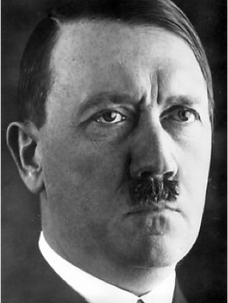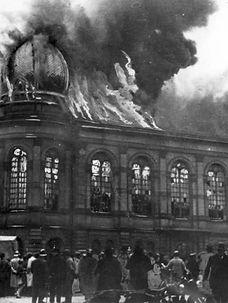Timeline of The Holocaust
Open the following video that reviews the timeline of The Holocaust: A Timeline of The Holocaust. Then answer the questions in your Museum Guide. As you listen, pay close attention to events, ideas, people, etc. that you might want to conduct your own research on when you get to Exhibit 7. Read below the video to read about details mentioned in the film.
*Note – Entries in bold italics in the following slides refer to events described or alluded in the memoir Night.


1933
-
The Nazi party takes power in Germany
-
Nazi “temporarily” suspend civil liberties for all citizens.
-
Books contrary to Nazi beliefs are burned in public
1934
-
Hitler becomes “Fuhrer,” or leader, of Germany
1935
-
Jews in Germany are deprived of citizenship and fundamental rights
-
Nazis intensify persecution of those considered “racially inferior”
-
Many are sent to concentration camps


1938
On Kristallnacht (the “Night of Broken Glass”), Nazi gangs physically attack Jews throughout Germany and Austria
“Night of Broken Glass”: On the night of November 9, 1938, violence against Jews broke out across the Reich. It appeared to be unplanned, set off by Germans’ anger over the assassination of a German official in Paris at the hands of a Jewish teenager. In two days, over 1,000 synagogues were burned, 7,000 Jewish businesses were trashed and looted, dozens of Jewish people were killed, and Jewish cemeteries, hospitals, schools, and homes were looted while police and fire brigades stood by. The pogroms became known as Kristallnacht, the “Night of Broken Glass,” for the shattered glass from the store windows that littered the streets.
The morning after the pogroms 30,000 German Jewish men were arrested for the “crime” of being Jewish and sent to concentration camps10, where hundreds of them perished. Some Jewish women were also arrested and sent to local jails. Businesses owned by Jews were not allowed to reopen unless they were managed by non-Jews. Curfews were placed on Jews, limiting the hours of the day they could leave their homes.
After the “Night of Broken Glass,” life was even more difficult for German and Austrian Jewish children and teenagers. Already barred from entering museums, public playgrounds, and swimming pools, now they were expelled from the public schools. Jewish youngsters, like their parents, were totally segregated in Germany. In despair, many Jewish adults committed suicide. Most families tried desperately to leave.

1939
-
On September 1, Germany invades Poland
-
Hitler orders the systematic murder of the mentally and physically disabled in Germany and Austria
-
Polish Jews are required to wear armbands or yellow stars
1940
Nazis begin deporting German Jews to Poland
Jews are forced into ghettos
With Germany’s backing, Hungary annexes parts of Romania, including Sighet and other towns in northern Transylvania
1941
-
Mobile killing units begin the systematic slaughter of Jews
-
In 2 days, one of those units was responsible for the murder of 33,771 Ukrainian Jews at Babi Yar
-
Hungary deports 17,000 foreign and “stateless” Jews.
-
Several thousand are used as slave laborers. The Nazis massacre the rest.
-
Twelve-year-old Elie Wiesel begin studying the Kabbalah
1942
Nazi officials turn over the “Final Solution” – their plan to kill all European Jews

1943
February – About 80 to 85% of the Jews who would die in the Holocaust have already perished.
April – Jews in Poland’s Warsaw Ghetto strike back as the Nazis begin new rounds of deportations. It takes nearly a month for the Nazis to put down the uprising

1944
March – Hitler occupies Hungary
June – the Germans are deporting 12,000 Hungarian Jews a DAY to Auschwitz
May- Elie Wiesel is fifteen years old when he and his family are deported by the Hungarian gendarmerie and the German SS and police from Sighet to Auschwitz. His mother and younger sister perish; his two older sisters survive.
1945
-
January – As the Russian army pushes west, the Nazis begin to evacuate death camps, including Auschwitz
-
Elie and his father are transferred to Buchenwald concentration camp, near Weimar Germany. Elie's father dies in January; Elie is liberated with the arrival of US troops in April
-
April – American forces liberate the prisoners in Buchenwald
-
May – WWII ends in Europe with Hitler’s defeat
-
The Holocaust is over; about one-third of all the Jews in the world are murdered and the survivors are homeless
1946
An International Military Tribunal created by Britain, France, the U.S., and the Soviet Union tries Nazi leaders for war crimes and crimes against humanity in Nuremberg

Elie's Journey